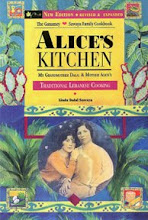Growing up in Alice's Kitchen, sweets and pastries were reserved for special occasions and holidays rather than a regular after-dinner event. a big bowl of fresh, seasonal fruits was our typical dessert, while the homemade farmers' cheese (
jibn) and olives that mother and
sitto cured from our tree in the front yard remained on the dinner table with some arabic bread, fig jam, and the occasional
halawe (halvah).
mother's irresistable homemade
baklawe (baklava) was for the holidays, when she'd graciously package up numerous tins of sweets to share with friends, guests, neighbors, and relatives visiting from arizona or other far away places.
her
baklawe—so light and delicious—one piece was never enough. this quality distinguishes our
baklawe from others that are so heavily laden with syrup and sweet, one piece can be too much! in the old country (lebanon), people made their own filo pastry, but thank goodness in LA in the 1950s there was one Arabic grocery store Nasrawey's on Hollywood Boulevard, where they sold frozen filo pastry dough. how lucky we are now that most supermarkets in major cities carry this, making
baklawe a fun holiday baking project with kids, as they love brushing on the butter, and grinding the walnuts in an old-fashioned nut grinder!
so i'm getting in the mood to make
baklawe to fill the Christmas tins i just bought and to use the fresh crop of walnuts from my tree—rescued from the squirrels this year by my hero doggie,
baba ghannouj! here's a photo of last year's tray. making this is much easier than one would imagine, and the results are worth the effort.
i use a utility paint brush to spread the melted butter. and instead of basting each filo sheet, save time by placing two sheets at a time which coats each sheet on one side. half of the buttered filo dough goes on the bottom of the baking tray, then a layer of walnuts, sugar, and orange flower water mixed together, and then the final layer of filo brushed with butter. a sharp knife is best to cut diamond-shaped pieces before baking. when the hot
baklawe is removed from the oven, a cold simple syrup flavored with orange flower water or rose water and a little lemon juice is drizzled over the top. agave syrup works beautifully in place of sugar! the pieces need to be cut through again, but one buttery bite of this Arabic delicacy is heaven-sent! happy holidays and happy baking!
oh, yes, of course the complete recipes for baklawe, jibn, and how to cure olives are in Alice's Kitchen: Traditional Lebanese Cooking! so order your copies now for holiday baking and gift giving!











